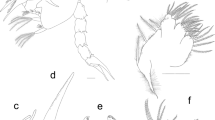Abstract
Early larvae of Flabby Sculpin, Zesticelus profundorum, are described using DNA barcoding methods to identify specimens collected in the Gulf of Alaska and Bering Sea. Based on the low myomere count, distribution of larvae, and vertebral counts in adults, we selected Zesticelus profundorum and Sebastolobus macrochir as good potential candidates for genetic comparison. We used DNA samples from voucher specimens of each candidate taxon to identify species-specific sequences. An exact match in sequence data allowed us to positively identify these larvae as Zesticelus profundorum, a rare deepwater species of the family Cottidae.


Similar content being viewed by others
References
Blood DM, Matarese AC (2010) Larval development and identification of the genus Triglops (Scorpaeniformes: Cottidae). NOAA Prof Paper NMFS 10
Carr SM, Kivlichan DS, Pepin P, Crutcher D (1999) Molecular systematics of gadid fishes: implications for the biogeographic origins of Pacific species. Can J Zool 77:19–26
Doyle M, Picquelle SJ, Mier KL, Spillane MC, Bond NA (2009) Larval fish abundance and physical forcing in the Gulf of Alaska, 1981–2003. Prog Oceanogr 80:163–187
Gharrett AJ, Gray AK, Heifetz J (2001) Identification of rockfish (Sebastes spp.) by restriction site analysis of the mitochondrial ND-3/ND-4 and 12S/16S rRNA gene regions. Fish Bull 99:49–62
Hall TA (1999) BioEdit: a user-friendly biological sequence alignment editor and analysis program for Windows 95/98/NT. Nucl Acids Symp Ser 41:95–98
Hebert P, Cywinska A, Ball SL, deWaard JR (2003) Biological identifications through DNA barcodes. Proc R Soc London B 270:313–321
Matarese AC, Kendall AW, Blood DM, Vinter BM (1989) Laboratory guide to the early life history stages of Northeast Pacific fishes. NOAA Tech Rep NMFS 80
Matarese AC, Blood DM, Picquelle SJ, Benson JL (2003) Atlas of abundance and distribution patterns of ichthyoplankton from the Northeast Pacific Ocean and Bering Sea ecosystems based on research conducted by the Alaska Fisheries Science Center (1972–1996). NOAA Prof Paper NMFS 1
Mecklenburg CW, Mecklenburg TA, Thorsteinson LK (2002) Fishes of Alaska. American Fisheries Society, Bethesda, Maryland
Moser GH (1996) The early stages of fishes in the California Current region. Calif Coop Oceanic Fish Invest Atlas 33
Nakabo T (ed) (2002) Fishes of Japan with pictorial keys to the species, English edn. Tokai University Press, Tokyo
Pegg GG, Sinclair B, Briskey L, Aspden WJ (2006) MtDNA barcode identification of fish larvae in the southern Great Barrier Reef, Australia. In: Olivar MP, Govoni JJ (eds) 29th Annual Larval Fish Conference Vol 70S2, Scientia Marina Barcelona, Spain 178
Potthoff T (1984) Clearing and staining techniques. In: Moser HG et al. (eds) Ontogeny and systematics of fishes. Spec Publ 1, Am Soc Ichthyol Herpetol Allen Press, Lawrence, Kansas, pp 35–37
Richardson DE, Vanwye JD, Exum AM, Cowen RK, Crawford DL (2007) High-throughput species identification: from DNA isolation to bioinformatics. Mol Ecol Notes 7:199–207
Saitoh K, Uehara S, Tega T (2009) Genetic identification of fish eggs collected in Sendai Bay and off Johban, Japan. Ichthyol Res 56:200–203
Spies IB, Gaichas S, Stevenson D, Orr J, Canino MF (2006) DNA-based identification of Alaska skates (Amblyraja, Bathyraja and Raja: Rajidae) using cytochrome c oxidase subunit I (coxI) variation. J Fish Biol 69(Suppl B):283–292
Ward RD, Zemlak TS, Innes BH, Last PR, Hebert P (2005) DNA barcoding Australia’s fish species. Phil Trans R Soc B 360:1847–1857
Yabe M, Okamura O (1993) Redescription of a rare cottid, Zesticelus bathybius. Jpn J Ichthyol 40:369–371
Yabe M (1995) A new species of sculpin, Zesticelus ochotensis (Scorpaeniformes: Cottidae), from the Southwestern Okhotsk Sea. Jpn J Ichthyol 42:17–20
Acknowledgments
The illustration was supplied by Beverly Vinter (AFSC, retired). Mike Canino’s efforts to build a bridge between genetic and morphological studies of fish taxonomy and systematics at AFSC were instrumental in the initiation and success of this ongoing study. We also thank the following individuals for providing at-sea assistance sorting plankton samples: Deborah Blood, Janet Duffy-Anderson and Annette Dougherty (AFSC). Lisa De Forest (AFSC) measured the fish larvae and provided technical support. Dawn Roje and Katherine Maslenikov (UW) assisted us in mapping the distribution of adults and larvae and obtaining adult tissue samples, respectively. Lastly, the mystery black larvae would not have been identified without lively discussions with our fellow Tuesday Fish Lunch companions, Duane Stevenson and Deborah Blood, who also reviewed an earlier version of this report.
Author information
Authors and Affiliations
Corresponding author
About this article
Cite this article
Matarese, A.C., Spies, I.B., Busby, M.S. et al. Early larvae of Zesticelus profundorum (family Cottidae) identified using DNA barcoding. Ichthyol Res 58, 170–174 (2011). https://doi.org/10.1007/s10228-010-0198-7
Received:
Revised:
Accepted:
Published:
Issue Date:
DOI: https://doi.org/10.1007/s10228-010-0198-7




